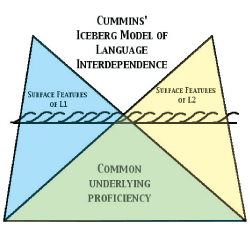 Cummins' Interdependence Hypothesis
Cummins' Interdependence Hypothesis

Is it true that the more languages you know, the easier they are to learn? Here, Marguerite is hoping that this is the case. She has been given another language to teach and she is hoping that her French students will be able to use their language skills to learn Spanish. Marguerite may know, from taking multiple languages herself, that many theorists suggest that languages are interconnected to one another. Cummins’ Interdependence Hypothesis focuses on this concept, offering some insight into how languages may influence one another. |
back to case study |
 What is the Interdependence Hypothesis?
What is the Interdependence Hypothesis?
Cummins' interdependence or iceberg hypothesis reveals the relationship of the first language to the learning of another language. What appears to be two very different phenomena on or above the surface is actually interdependent psychologically.
What is the Common Underlying Proficiency?
The Common Underlying Proficiency (CUP) model or the "one balloon theory" described by Jim Cummins purports that proficiencies involving more cognitively demanding tasks (such as literacy, content learning, abstract thinking and problem-solving) are common across languages. The CUP model is represented with the "dual iceberg metaphor" and is the basis of the hypothesis called the linguistic interdependence hypothesis.
What else does Cummins say?
LINGUISTIC INTERDEPENDENCE HYPOTHESIS:
This hypothesis, represented as a "dual-iceberg," posits that every language contains surface features; however, underlying those surface manifestations of language are proficiencies that are common across languages. The dimension of language used in more cognitively demanding tasks that involve more complex language is CALP, which is transferable across languages.
THRESHOLD HYPOTHESIS:
This hypothesis proposed by Jim Cummins is called the additive bilingualism enrichment principle. It explains the relationship between bilingualism and cognition, supporting the notion that individuals with high levels of proficiency in both language experience cognitive advantages in terms of linguistic and cognitive flexibility while low levels of proficiency in both languages result in cognitive deficits. This hypothesis further describes the three types of bilinguals (Proficient, Partial, and Limited) and two distinct processes of bilingualism as additive bilingualism and subtractive bilingualism.
ADDITIVE BILINGUALISM:
This is a process by which students develop both fluency and proficiency in a second language while continuing to develop proficiency in their first. The process involves adding a second language, not replacing the first language with the second language (which is known as subtractive bilingualism).
BICS & CALP:
These terms are commonly used in discussion of bilingual education and arise from the early work of Cummins (1984) in which he demonstrated his ideas about the two principal continua of second language development in a simple matrix. BICS describes the development of conversational fluency (Basic Interpersonal Communicative Skills) in the second language, whereas CALP describes the use of language in decontextualized academic situations (Cognitive Academic Language Proficiency ). For more information on BICS & CALP click here.
back to top
 |
Test your knowledge of Cummins Interdependence (Iceberg) Hypothesis with this quiz. |










